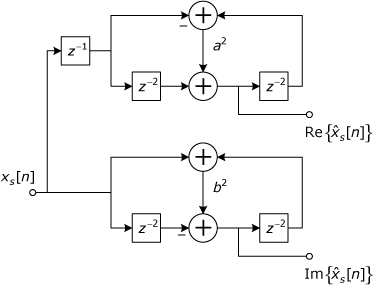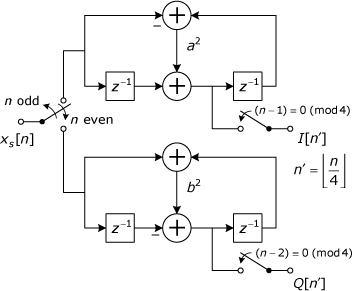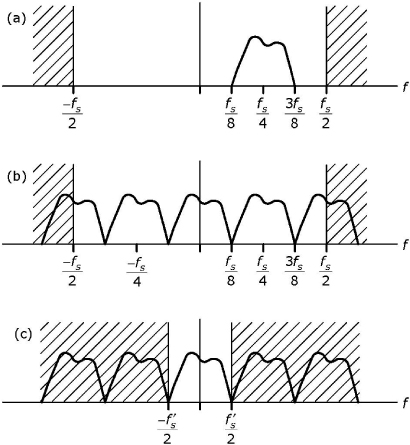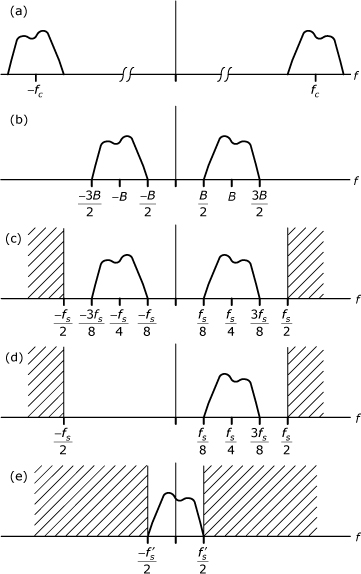Note 65. Generating I and Q Channels Digitally: Rader’s Approach
This note presents an approach for generating inphase and and quadrature channels from a digitized, real-valued bandpass signal.
Radar and communications systems often involve quadrature receivers, which typically exhibit mismatch or imbalances between the amplitude and phase responses of their inphase and quadrature output channels. These imbalances introduce distortion into the signals of interest that are derived from the I and Q outputs of the receiver. Rader’s approach is one of several digital I/Q techniques that have been devised to form the I and Q signals directly from a single real bandpass signal and thereby avoid the I/Q matching limitations of analog quadrature receivers.
65.1. The Approach
Recipe 65.1 implements a digital I/Q approach depicted in Figure 65.1 and originally described by Rader in [1, 2]. The analytic signal generation (ASG) filter shown in the diagram can be implemented using any of the methods described in Notes 60 through 64. However, in [1], Rader initially implements this filter as a phase-splitting network consisting of a pair of low-order IIR filters, as shown in Figure 65.3. The top branch, which generates the real part of ![]() , implements the transfer function
, implements the transfer function
65.1

Figure 65.1. Block diagram of processing steps in Rader’s digital I/Q approach

The bottom branch, which generates the imaginary part of ![]() , implements the transfer function
, implements the transfer function
65.2

The coefficients a2 and b2 can be obtained using the design procedure presented in Note 63. Rader points out that because the filter output, ![]() , is destined to be down sampled by a factor of 4, it is possible to build a more efficient filter that absorbs the downsampling operation and generates only every fourth output. This improved realization is shown in Figure 65.4. The down sampling is accomplished by the switches on the output lines.
, is destined to be down sampled by a factor of 4, it is possible to build a more efficient filter that absorbs the downsampling operation and generates only every fourth output. This improved realization is shown in Figure 65.4. The down sampling is accomplished by the switches on the output lines.
Careful examination of Figure 65.3 reveals that even-indexed samples of Re![]() depend only upon odd-indexed samples of
depend only upon odd-indexed samples of ![]() , and even-indexed samples of Im
, and even-indexed samples of Im![]() depend only upon even-indexed samples of
depend only upon even-indexed samples of ![]() . The input switch shown in Figure 65.4 routes odd-indexed samples to the top branch and even-indexed samples to the bottom branch, thereby enabling each branch to run at half the original sample rate. Because of the reduced rate, the z–2 delays become z–1delays. The z–1 delay in the top branch of Figure 65.3 is accomplished by the relative phasing of the output switch closures in Figure 65.4. To establish the proper phasing, the sample of Q[n′] that is generated when n = 0 is discarded so that I[0] is generated when n = 1, and Q[0] is generated when n = 2.
. The input switch shown in Figure 65.4 routes odd-indexed samples to the top branch and even-indexed samples to the bottom branch, thereby enabling each branch to run at half the original sample rate. Because of the reduced rate, the z–2 delays become z–1delays. The z–1 delay in the top branch of Figure 65.3 is accomplished by the relative phasing of the output switch closures in Figure 65.4. To establish the proper phasing, the sample of Q[n′] that is generated when n = 0 is discarded so that I[0] is generated when n = 1, and Q[0] is generated when n = 2.
Figure 65.3. IIR realization for the complex filter

Figure 65.4. Improved IIR realization for the complex filter

Normally, shifting a bandpass spectrum such as Figure 65.2(d) to create a baseband spectrum such as Figure 65.2(e) would require some sort of mixing operation. However, the particular combination of center frequency and sampling rate used in Rader’s approach completely eliminates the need for a final mixing step. If the signal corresponding to the spectrum in Figure 65.5(a) is downsampled by a factor of 4, two things happen:
- Images of the spectrum are created at intervals of the new sampling rate,
 , as shown in Figure 65.5(b).
, as shown in Figure 65.5(b). - The supported passband of the system changes from ±fS/2 to
 , with exactly one image of the signal’s spectrum falling in this new passband, as shown in Figure 65.5(c).
, with exactly one image of the signal’s spectrum falling in this new passband, as shown in Figure 65.5(c).
Figure 65.5. When the signal having the spectrum in (a) is downsampled by a factor of 4, images are created at intervals of fs/4, as in (b), and the supported passband shrinks, as depicted in (c), from ±fs/2 to ±f′s/2 where f′s = fs/4.

References
1. C. M. Rader, “A Simple Method for Sampling In-Phase and Quadrature Components,” IEEE Trans. Aerospace and Electronic Syst., vol. 20, no. 6, Nov. 1984, pp. 821–824.
2. C. M. Rader, “Method and Apparatus for Sampling In-Phase and Quadrature Components,” U. S. Patent 4,794,556, dated Dec. 27, 1988.
3. B. Gold and C. M. Rader, Digital Processing of Signals, McGraw-Hill, 1969.

